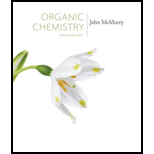
Organic Chemistry
9th Edition
ISBN: 9781305080485
Author: John E. McMurry
Publisher: Cengage Learning
expand_more
expand_more
format_list_bulleted
Concept explainers
Textbook Question
Chapter 1.SE, Problem 50AP
Most stable organic species have tetravalent carbon atoms, but species with trivalent carbon atoms also exist. Carbocations are one such class of compounds.

(a) How many valence electrons does the positively charged carbon atom have?
(b) What hybridization do you expect this carbon atom to have?
(c) What geometry is the carbocation likely to have?
Expert Solution & Answer
Trending nowThis is a popular solution!

Students have asked these similar questions
Briefly explain what the infinite dilution rate constant (k∞) consists of.
The Davies equation corrects the Debye-Hückel limiting law for calculating the
activity coefficient of an electrolyte in solution at relatively high concentrations.
Mathematically, it is expressed as: log y₁ = -Az²?
1 + √Ĩ
- 0,31)
Is the formula correct?
Differentiate between the concepts of "ionic salt effect" and "kinetic salt effect."
Chapter 1 Solutions
Organic Chemistry
Ch. 1.3 - Give the ground-state electron configuration for...Ch. 1.3 - How many electrons does each of the following...Ch. 1.4 - Prob. 3PCh. 1.4 - Convert the following representation of ethane,...Ch. 1.4 - What are likely formulas for the following...Ch. 1.4 - Prob. 6PCh. 1.4 - Prob. 7PCh. 1.7 - Draw a line-bond structure for propane, CH3CH2CH3....Ch. 1.7 - Convert the following molecular model of hexane, a...Ch. 1.8 - Draw a line-bond structure for propene, CH3CH=CH2....
Ch. 1.8 - Draw a line-bond structure for 1, 3-butadiene,...Ch. 1.8 - Following is a molecular model of aspirin...Ch. 1.9 - Draw a line-bond structure for propyne, CH3C≡CH....Ch. 1.10 - Prob. 14PCh. 1.12 - Prob. 15PCh. 1.12 - Prob. 16PCh. 1.12 - The following molecular model is a representation...Ch. 1.SE - Convert each of the following molecular models...Ch. 1.SE - The following model is a representation of citric...Ch. 1.SE - The following model is a representation of...Ch. 1.SE - The following model is a representation of...Ch. 1.SE - How many valence electrons does each of the...Ch. 1.SE - Give the ground-state electron configuration for...Ch. 1.SE - Prob. 24APCh. 1.SE - Prob. 25APCh. 1.SE - Draw an electron-dot structure for acetonitrile,...Ch. 1.SE - Draw a line-bond structure for vinyl chloride,...Ch. 1.SE - Fill in any nonbonding valence electrons that are...Ch. 1.SE - Convert the following line-bond structures into...Ch. 1.SE - Convert the following molecular formulas into...Ch. 1.SE - Prob. 31APCh. 1.SE - Oxaloacetic acid, an important intermediate in...Ch. 1.SE - Prob. 33APCh. 1.SE - Potassium methoxide, KOCH3, contains both covalent...Ch. 1.SE - What is the hybridization of each carbon atom in...Ch. 1.SE - Prob. 36APCh. 1.SE - Prob. 37APCh. 1.SE - What bond angles do you expect for each of the...Ch. 1.SE - Propose structures for molecules that meet the...Ch. 1.SE - What kind of hybridization do you expect for each...Ch. 1.SE - Pyridoxal phosphate, a close relative of vitamin...Ch. 1.SE - Prob. 42APCh. 1.SE - Prob. 43APCh. 1.SE - Quetiapine, marketed as Seroquel, is a heavily...Ch. 1.SE - Tell the number of hydrogens bonded to each carbon...Ch. 1.SE - Why do you suppose no one has ever been able to...Ch. 1.SE - Allene, H2C=C=CH2, is somewhat unusual in that it...Ch. 1.SE - Allene (see Problem 1-47) is structurally related...Ch. 1.SE - Complete the electron-dot structure of caffeine,...Ch. 1.SE - Most stable organic species have tetravalent...Ch. 1.SE - A carbanion is a species that contains a...Ch. 1.SE - Divalent carbon species called carbenes are...Ch. 1.SE - There are two different substances with the...Ch. 1.SE - There are two different substances with the...Ch. 1.SE - There are two different substances with the...Ch. 1.SE - Prob. 56APCh. 1.SE - Among the most common over-the-counter drugs you...
Knowledge Booster
Learn more about
Need a deep-dive on the concept behind this application? Look no further. Learn more about this topic, chemistry and related others by exploring similar questions and additional content below.Similar questions
- Differentiate the concepts of “salino effect” and “salino kinetic effect”.arrow_forwardCome and compare the Bronsted-Bjerrum calculation, the Debye and Hückel calculation, and the Davies calculation.arrow_forwardplz watch the youtube video (the title of this topic) by roxi H. she explains it step by step but i get the wrong answerarrow_forward
- Writing the rate law implied by a simple mechanism To exit full screen, press and hold esc Suppose the decomposition of ozone proceeds by the following mechanism: step elementary reaction rate constant 1 →>> O3(9) O2(g) + O(g) k₁ 2 03(g) + O(g) → 202(g) k2 Suppose also k₁ »k2. That is, the first step is much faster than the second. Write the balanced chemical equation for the overall chemical reaction: Write the experimentally- observable rate law for the overall chemical reaction. ☐ rate = ☐ Note: your answer should not contain the concentrations of any intermediates. Express the rate constant k for the overall chemical reaction in terms of K1, K2, and (if necessary) the rate constants k-1 and K-2 for the reverse of the two elementary reactions in the mechanism. k = ☐ 000 18 ローロ Ar OOarrow_forwardDeducing a rate law from the change in concentration over time To exit full screen, press and hold esc A chemistry graduate student is studying the rate of this reaction: H2CO3(aq) → H₂O(aq) +CO₂ (aq) - She fills a reaction vessel with H2CO3 and measures its concentration as the reaction proceeds: time (milliseconds) [H2CO3] 0 0.0500 M 10. 0.0266M 20. 0.0181 M 30. 0.0138M 40. 0.0111 M Use this data to answer the following questions. Write the rate law for this reaction. Calculate the value of the rate constant k. Round your answer to 2 significant digits. Also be sure your answer has the correct unit symbol. rate ☐ x10 k = Х 000 18 Ararrow_forwardWriting the rate law implied by a simple mechanism Suppose the formation of tert-butanol proceeds by the following mechanism: step elementary reaction 1 (CH3)3 CBr(aq) → (CH3)2 C* (aq) + Br (aq) 2 (CH3)2C (aq) + OH¯ (aq) → (CH3)2COH(aq) rate constant k₁ k₂ Suppose also k₁ »k2. That is, the first step is much faster than the second. Write the balanced chemical equation for the overall chemical reaction: Write the experimentally- observable rate law for the overall chemical reaction. Note: your answer should not contain the concentrations of any intermediates. rate = k ☐ Express the rate constant k for the overall chemical reaction in terms of K1, K2, and (if necessary) the rate constants k-1 and K-2 for the reverse of the two elementary reactions in the mechanism. k = ☐ □ ☑ G ? 00. 18 Ar Barrow_forward
- Deducing a rate law from the change in concentration over time A chemistry graduate student is studying the rate of this reaction: 2SO3 (g) →>> 2SO2 (g) + O2(g) He fills a reaction vessel with SO3 and measures its concentration as the reaction proceeds: ? time (minutes) [SO3] 0 0.0200M 1.0 0.0105 M 2.0 0.00552M 3.0 0.00290M 4.0 0.00152M Use this data to answer the following questions. Write the rate law for this reaction. rate = k ☐ x10 Calculate the value of the rate constant k. Round your answer to 2 significant digits. Also be sure your answer has the correct unit symbol. k = ☐ Х 000 18 Ar BAarrow_forwardUsing the Arrhenius equation to calculate k at one temperature from k at... The rate constant of a certain reaction is known to obey the Arrhenius equation, and to have an activation energy E reaction is 1.2 × 107 M −1 .S at 160.0 °C, what will the rate constant be at 194.0 °C? Round your answer to 2 significant digits. k = Шм −1 -1 .S ☐ x10 ☑ 5 = = 16.0 kJ/mol. If the rate constant of this a ? olo Ar Barrow_forwardUsing the Arrhenius equation to calculate k at one temperature from k at... a The rate constant of a certain reaction is known to obey the Arrhenius equation, and to have an activation energy E = 10.0 kJ/mol. If the rate constant of this reaction is 9.9 × 107 M -1 .S at 246.0 °C, what will the rate constant be at 196.0 °C? Round your answer to 2 significant digits. k = ☐ M -1 −1 .S x10 ☑ ? 00. 18 Ar Barrow_forward
- Writing the rate law implied by a simple mechanism Suppose the reaction between nitric oxide and bromine proceeds by the following mechanism: elementary reaction - NO(g) + Br2(g) → NOBг2(g) step 1 2 NOBг2(g) + NO(g) - rate constant k₁ 2 NOBr(g) k2 Suppose also k₁ »k2. That is, the first step is much faster than the second. Write the balanced chemical equation for the overall chemical reaction: Write the experimentally- observable rate law for the overall chemical reaction. Note: your answer should not contain the concentrations of any intermediates. ☐ rate = k Express the rate constant k for the overall chemical reaction in terms of k₁, k2, and (if necessary) the rate constants k-1 and K-2 for the reverse of the two elementary reactions in the mechanism. = ☐ ロ→ロ Х ك ? 000 18 Ararrow_forwardDeducing a rate law from the change in concentration over time chemistry graduate student is studying the rate of this reaction: 2H3PO4 (aq) → P₂O5 (aq) +3H₂O (aq) 2 e fills a reaction vessel with H3PO and measures its concentration as the reaction proceeds: 4 time (seconds) [H3PO4] 0 0.500M 1.0 0.229 M 2.0 0.148M 3.0 0.110M 4.0 0.0871 M se this data to answer the following questions. Write the rate law for this reaction. rate = k x10 Calculate the value of the rate constant k. k = Round your answer to 2 significant digits. Also be sure your answer has the correct unit symbol. ☑ G olo 18 Ararrow_forwardWriting the rate law implied by a simple mechanism Suppose the formation of nitrosyl chloride proceeds by the following mechanism: elementary reaction step rate constant 1 NO(g) + Cl2(g) → NOC₁₂(g) k₁ 2 NOCl2(g) + NO(g) 2 NOCl(g) →>> k2 Suppose also k₁ »k. That is, the first step is much faster than the second. Write the balanced chemical equation for the overall chemical reaction: Write the experimentally- observable rate law for the overall chemical reaction. rate = k ☐ Note: your answer should not contain the concentrations of any intermediates. Express the rate constant k for the overall chemical reaction in terms of K1, K2, and (if necessary) the rate constants k-1 and K-2 for the reverse of the two elementary reactions in the mechanism. k = | Х ? 18 Ararrow_forward
arrow_back_ios
SEE MORE QUESTIONS
arrow_forward_ios
Recommended textbooks for you
 Chemistry: The Molecular ScienceChemistryISBN:9781285199047Author:John W. Moore, Conrad L. StanitskiPublisher:Cengage Learning
Chemistry: The Molecular ScienceChemistryISBN:9781285199047Author:John W. Moore, Conrad L. StanitskiPublisher:Cengage Learning

Chemistry: The Molecular Science
Chemistry
ISBN:9781285199047
Author:John W. Moore, Conrad L. Stanitski
Publisher:Cengage Learning
INTRODUCTION TO MOLECULAR QUANTUM MECHANICS -Valence bond theory - 1; Author: AGK Chemistry;https://www.youtube.com/watch?v=U8kPBPqDIwM;License: Standard YouTube License, CC-BY